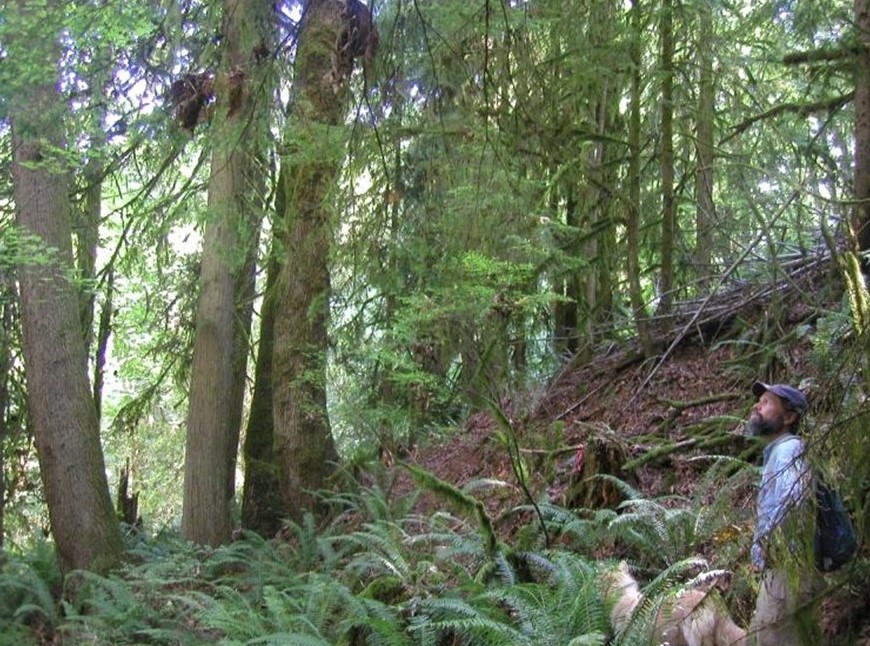Member Highlight – Advice from Butler Family Forest on Cost-Share Programs

NNRG FSC member Paul Butler’s story is a testament to the benefits of leveraging cost-share programs for forest management. He took a break from installing plant protectors to share his advice and knowledge. Paul owns an 80-acre forest in Thurston County, where he has enhanced his land and deepened his commitment to forest stewardship.
Beginnings and Initial Challenges
Paul’s adventure began in 1994 when he purchased his first 40 acres. One of the early challenges he faced was dealing with a blown-out culvert, which blocked access to his property. To address this, he did what he calls the “worst first commercial thin” and harvested mature alder trees, using the proceeds to pay for a bridge to his property. This critical infrastructure project was needed to apply for EQIP funding.
Paul’s connection to forestry is deeply personal. Acquiring the original 40 was inspired by his wife, a botanist with the US Forest Service. They originally planned to live off the grid but decided to stay in their home and manage their nearby forest. This decision led Paul to discover the DNR small forest landowner office (SFLO), where he attended a talk at Wild Thyme Farm and connected with Kirk Hanson, who was at the time an SFLO representative. We now know Kirk as NNRG’s Director of Forestry and, for Paul, a trusted partner in managing their forest land. Retired and seeking a new career, in 2017, he expanded his holdings with an additional 40 acres.
Navigating Cost-Share Programs
His foray into using cost-share programs started in 2008, marking a significant turning point. “There was a steep learning curve for all involved,” Paul recalls, but the ambitious five-year plan was well worth it.
Paul’s subsequent engagement with the Natural Resources Conservation Service (NRCS) created a forest management plan (FMP) for his newly acquired parcel. “Having an FMP is crucial and well worth it,” he advises other landowners.
He describes the NRCS as easy to work with, though they document everything meticulously. “Their office has a bookshelf full of files from him,” he notes. Despite the bureaucratic process, Paul found the NRCS’s assistance invaluable. His following EQIP grant helped him tackle overstocked root rot pockets and scraggly alder.
Paul’s persistence paid off. Over the years, he transitioned through multiple NRCS programs, including the Environmental Quality Incentives Program (EQIP) and the Conservation Stewardship Program (CSP). These programs funded various projects, from forest health improvements to carbon sequestration efforts.
Paul’s Advice for Other Forest Owners
While reflecting on his journey, Paul offers advice for fellow forest landowners.
- Develop a Forest Management Plan (FMP), essential for starting any cost-share program.
- Follow the Rules – The NRCS is a legitimate program that requires adherence to its processes, but they are well worth it.
- Stay Patient – The process can be lengthy, but the benefits are substantial. Paul said to plan for a year and a half from interest to implementation.
- Utilize Technical Assistance – Working with professionals can help anticipate problems and increase success. Paul has learned a lot from NRCS and DNR. He also values the support from Kirk and NNRG over the years. Take advantage of all the resources available!
The future of the Butler Family Forest
Paul’s background as an educator at Evergreen State College, where he taught Earth science, natural history, and Pacific Northwest forests, enriched his approach to forest management. His property has become a living classroom, demonstrating forest progress through various stages of growth and harvest. “I bring people out to show them good examples of how forests progress,” Paul says proudly. He is considering donating the land to the Capitol Land Trust, which would ensure the preservation of the forest for future generations. Paul’s story underscores the value of perseverance and the tangible benefits of cost-share programs.
Learn more about the Butler Family Forest from our 2017 video.

Leave a Reply